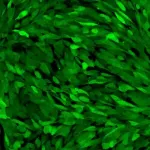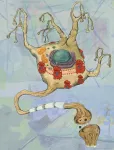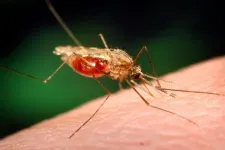(Press-News.org) ANN ARBOR, Michigan — Researchers at the University of Michigan Health Rogel Cancer Center are exploiting a unique biological feature of glioblastoma to gain a better understanding of how this puzzling brain cancer develops and how to target new treatments against it.
The team, led by senior author Pedro Lowenstein, M.D., Ph.D., Richard Schneider Collegiate Professor of Neurosurgery at Michigan Medicine, had previously identified oncostreams as a key feature in glioblastoma development and in more aggressive disease. These highly active, elongated, spindle-like cells move throughout tissue in complicated patterns. The accumulation of oncostreams found throughout a tumor serve as the basis for cancerous cells’ behavior, determining how tumors grow and invade normal tissue.
In this new study, published in Advanced Science, the team developed human and mouse models of glioblastoma oncostreams and examined multiple factors in the tumor microenvironment that could impact how oncostreams develop and how to reverse them.
Utilizing this model, they also identified a potential inhibitor, DDR1-IN-1, which appears to dismantle oncostreams. Preliminary studies in a mouse model of glioma showed the DDR1 inhibitor led to better survival. This suggests a potential pathway for additional research.
Glioblastoma is an aggressive cancer, with only a 5% survival rate beyond two years. In large part, it’s because even when surgery is possible, it’s often difficult to remove all the cancerous cells. Radiation and chemotherapy have limited effectiveness, and no other treatment options have been developed in decades. This work will hopefully lead to new clinical trials, like the phase I trial of dual vector gene therapy, supported in part by the Rogel Cancer Center, which was published recently in The Lancet Oncology.
“This model has deepened our understanding of how glioblastoma cells grow and invade and has led to the identification of a potential new therapeutic target,” said Syed M. Faisal, Ph.D., a postdoctoral fellow in Lowenstein’s lab and the first author of the study.
“Understanding the mechanism of how glioblastoma grows and migrates is essential to developing new and better treatments,” Lowenstein said. “Our oncostream model will be a valuable tool for gaining new insights into how glioma invades. It will allow us to test potential new therapeutic strategies that undermine the cellular and molecular foundations of glioblastoma malignancy.”
Additional authors: Jarred E. Clewner, Brooklyn Stack, Maria L. Varela, Andrea Comba, Grace Abbud, Sebastien Motsch, Maria G. Castro
Funding for this work is from National Institutes of Health grants: R37-NS094804, R01-NS105556, R01-NS122536, R01-NS124167, R01-NS122165, R21-NS123879-01, R01-NS076991, R01-NS096756, R01-NS082311, R01-NS122234, R01-NS127378, R01-EB022563, U01-CA224160, R01-CA243916; RNA Biomedicine; Rogel Cancer Center; Ian's Friends Foundation; Leah's Happy Hearts Foundation; Pediatric Brain Tumor Foundation; Smiles for Sophie Forever Foundation; ChadTough Foundation.
Disclosure: None
Paper cited: “Spatiotemporal Insights into Glioma Oncostream Dynamics: Unraveling Formation, Stability, and Disassembly Pathways,” Advanced Science. DOI: 10.1002/advs.202309796
Resources:
University of Michigan Rogel Cancer Center, www.rogelcancercenter.org
Michigan Medicine Cancer AnswerLine, 800-865-1125
# # #
END
LAWRENCE — A University of Kansas study of rare gene mutations that cause hereditary Alzheimer's disease shows these mutations disrupt production of a small sticky protein called amyloid.
Plaques composed of amyloid are notoriously found in the brain in Alzheimer’s disease and have long been considered responsible for the inexorable loss of neurons and cognitive decline. Using a model species of worm called C. elegans that’s often used in labs to study diseases at the molecular level, the research team came to the surprising conclusion that the stalled process of amyloid production — not the amyloid itself — can trigger loss of critical ...
HOUSTON – (Feb. 29, 2024) – Glass fiber-reinforced plastic (GFRP), a strong and durable composite material, is widely used in everything from aircraft parts to windmill blades. Yet the very qualities that make it robust enough to be used in so many different applications make it difficult to dispose of ⎯ consequently, most GFRP waste is buried in a landfill once it reaches its end of life.
According to a study published in Nature Sustainability, Rice University researchers and collaborators have developed a new, energy-efficient upcycling method to transform glass fiber-reinforced plastic ...
ITHACA, N.Y. – Cornell University astrobiologists have devised a novel way to determine ocean temperatures of distant worlds based on the thickness of their ice shells, effectively conducting oceanography from space.
Available data showing ice thickness variation already allows a prediction for the upper ocean of Enceladus, a moon of Saturn, and a NASA mission’s planned orbital survey of Europa’s ice shell should do the same for the much larger Jovian moon, enhancing the mission’s findings about whether it could support ...
NEW YORK, NY (February 29, 2024)--Columbia University Vagelos College of Physicians and Surgeons (VP&S) today announced the launch of a new center for pediatric cardiovascular innovation, made possible through a visionary gift by Lawrence Neubauer. The mission of the new center is to improve outcomes for patients through groundbreaking research and care and to define the next cures for and future practice in congenital heart disease (CHD)—here and across the world.
In recognition of the transformative generosity of Lawrence Neubauer, the center will be named the Garrett Isaac Neubauer Center for Cardiovascular ...
EAST LANSING, Mich. — Effective population level vaccination campaigns are fundamental to public health. Countercampaigns, which are as old as the first vaccines, can disrupt uptake and threaten public health globally.
Even before March 2020, vaccine hesitancy was directly linked to misinformation — false, inaccurate information promoted as factual — on social media. Once COVID-19 reached pandemic status, social media was acknowledged as the epicenter of information leading to vaccine hesitancy, which the World Health Organization, ...
Malaria kills more than 600,000 people each year worldwide, and two thirds are children under age five in sub-Saharan Africa. Scientists have found a treatment that could prevent thousands of these deaths: trees. New research conducted at the University of Vermont (UVM) and published today in the journal GeoHealth suggests forests can provide natural protection against disease transmission, particularly for the most vulnerable children.
Malaria spreads through the bite of Anopheles mosquitoes. While malaria is a disease long associated with lower socioeconomic status, the UVM study links deforestation with higher risk of the disease, particularly for ...
Washington, D.C. – The U.S. Department of Energy (DOE) announced the schedule for upcoming events and submissions associated with the competition for the management and operating contract for the Thomas Jefferson National Accelerator Facility (TJNAF).
TJNAF is a DOE national laboratory and DOE-sponsored Federally Funded Research and Development Center that has a mission focused on delivering breakthrough science and technology in nuclear physics.
DOE will host an informational meeting and site tour on March 27, 2024 at TJNAF to provide information regarding the site to interested parties. ...
U.S. flu vaccines are likely to move from quadrivalent to trivalent due to a change in circulating influenza viruses, says a University of Michigan researcher.
Currently, all influenza vaccines in the United States are quadrivalent, meaning that they protect against four different flu viruses.
In a new paper published in the New England Journal of Medicine, researchers detail the spread of influenza B/Yamagata virus, which has not been in circulation since early 2020; the regulatory discussions and recommendations on updating vaccines; and the manufacturing considerations ...
Glenview, IL– The American College of Chest Physicians® (CHEST) has received accreditation with commendation from the Accreditation Council for Continuing Medical Education (ACCME) and reaccreditation from the Society for Simulation in Healthcare (SSH).
This achievement grants CHEST reaccreditation through November 2029 and places the organization in the highest tier of all continuing medical education (CME) providers, including some of the nation’s most prestigious medical schools and professional medical societies.
“Receiving reaccreditation with commendation from the ACCME is a real testament to the education team at CHEST including both internal ...
CHAPEL HILL, N.C. – The Chan Zuckerberg Initiative (CZI) announced four multi-year Exploratory Cell Networks grants for researchers exploring the frontiers of genomics, cell biology, and synthetic biology by developing new measurement technologies. The projects will be bringing together regional labs in California, the Mid-Atlantic, and the Research Triangle.
Klaus Hahn, PhD, the Ronald G. Thurman Distinguished Professor of Pharmacology and member of the UNC Lineberger Comprehensive Cancer Center, will be co-leading a ...







